By Bill Carroll
Jackie Roosevelt Robinson: The Origins
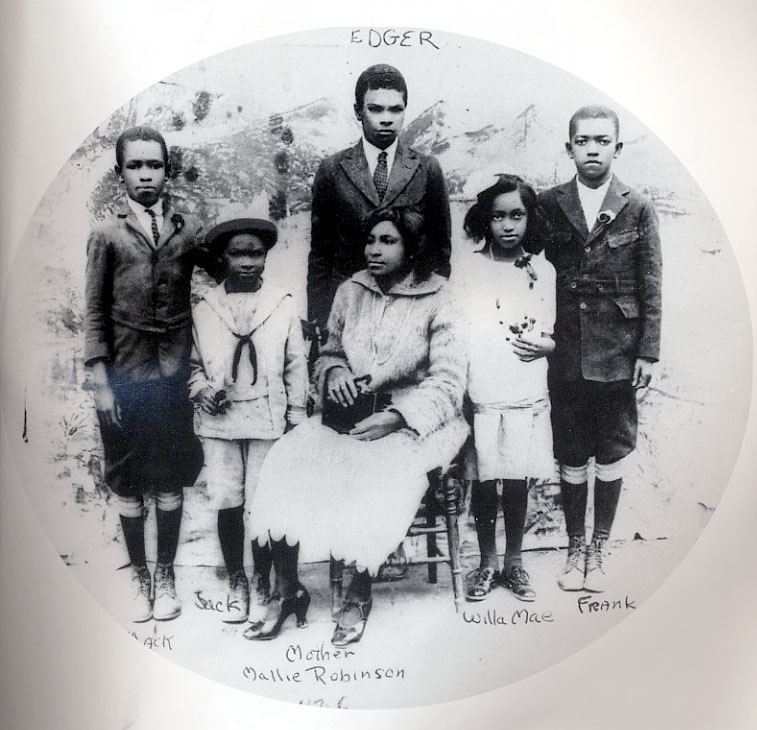
Jackie Roosevelt Robinson was born in Cairo, Georgia on January 31, 1919 to sharecroppers Jerry and Mallie Robinson. She was the seventh of fourteen children, Mallie had grown up on land owned by her parents and gone to school up to the sixth grade, which at that time and in that place was exceptional for Black girl in rural Georgia.
Born slaves, Wash and Edna McGriff emphasized the importance of education to their children; when Mallie was ten, she repaid her father by teaching him to read the Bible. Sunday, November 21, 1909, roughly three years after their first meeting, Mallie and Jerry Robinson were wed. Jerry and Mallie would have 2 daughters and 3 sons, including Matthew MacKenzie “Mack” Robinson, an Olympic Silver Medalist and Jackie Roosevelt Robinson. His father left the family in 1920 and Mallie moved her family to the city of Pasadena, Los Angeles County , California.
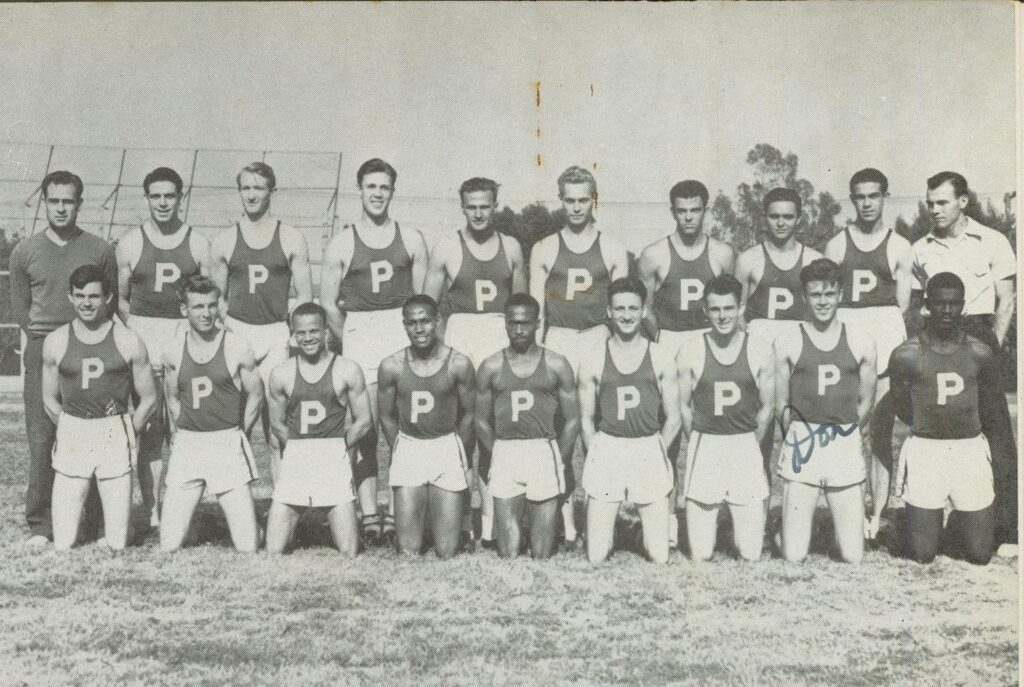
Jackie Roosevelt Robinson: The Youth
They were first Black family to live on Pepper Street in Pasadena, when they arrived in 1920. Mallie Robinson’s children, sons Edgar, Frank, Mack and Jackie and daughter Willa Mae. The Robinson children apparently adapted as well as possible to their new environs. They had left behind the smothering segregation of the South for a more laid-back Californian version of racism.
Pasadena, a wealthy, white and rather conservative enclave, was quite clear in not wanting its new, Black residents to feel too much at home. Redlining meant that home ownership was relegated to Whites and only in certain neighborhoods. Some public places like the community pool and the YMCA were off-limits to Blacks.
Mack, who was, age six when the family moved, and Jackie, who was only one, would carry these catalytic encounters with America’s moral cancer of racism, all of their days. Mack would eventually make his life’s work improving Pasadena, but, according to Robinson biographer, Arnold Rampersad, Jackie left Pasadena, never looking back, but always holding to the rage that was stoked in his soul, he grew and was surrounded by walls of racial obstacles. He knew that those were walls that some day he would topple, like the Walls of Jericho.
The first of the Robinson children to rise to prominence as an athlete was Matthew MacKenzie “Mack” Robinson. When he was starting middle school Mack was diagnosed with a heart murmur which worsened with age, so he was urged to play non-contact sports. He ended up concentrating on track-and-field, especially sprints and the long jump; he would set national junior college records in the 100m, 200m, and the long jump. The 1932 Olympics games in Los Angeles inspired Mack to train, despite the financial pressures and heart problems that almost ended his career aside, Mack trained in the face of those challenges, earning a spot on the 1936 U.S. Olympic team.
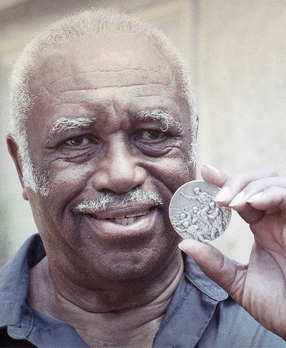
Mack won a silver medal at the Summer Olympics in Berlin, with a world record time of 21.1, but finishing .4 seconds behind Jesse Owens. In the 200, the US 1936 Olympics team fielded 18 Black American athletes, 12 of whom were track and field athletes.
While Mack was achieving glory, Jackie Roosevelt Robinson, about four and a half years younger, was carving out a niche for himself as a notable all-around athlete. In 1934, at age 15, he won the Pasadena, City Ping-Pong tournament. In 1935 Jackie Robinson graduated from Washington Junior High School and enrolled in John Muir High School (“Muir Tech”). There he played on various Muir Tech sport teams.
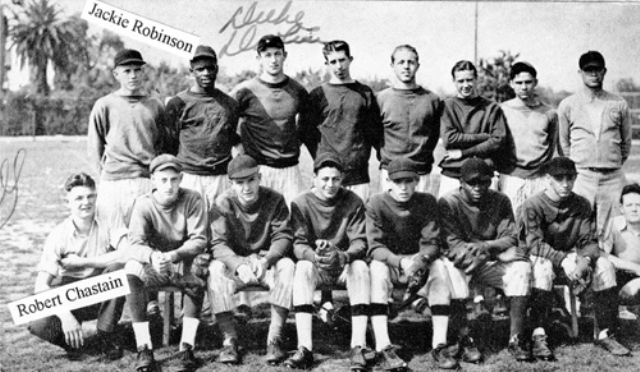
He was a shortstop and catcher on the baseball team, a quarterback on the football team, a guard on the basketball team, a member of the tennis team and the track and field squad. He won awards in the broad jump. This was the first team, with Black players, invited to, and allowed to participate in the 1935 Pomona Tournament. One which included future Major League Baseball Hall of Famers Ted Williams and Bob Lemon.
How important was this? The governor, Frank Merriam, was in attendance, comedian Joe E. Brown was the guest speaker and Mickey Rooney tossed out the first pitch for the championship game. Every evening, however, Robinson returned home to Pasadena, the hotels would not allow him to stay. He still finished with a tournament-high 11 stolen bases.
In 1936, Jackie Roosevelt Robinson won the boys singles championship in the annual Pacific Coast Negro Tennis Tournament, starred as quarterback and again earned a place on the annual Pomona baseball tournament all-star team.
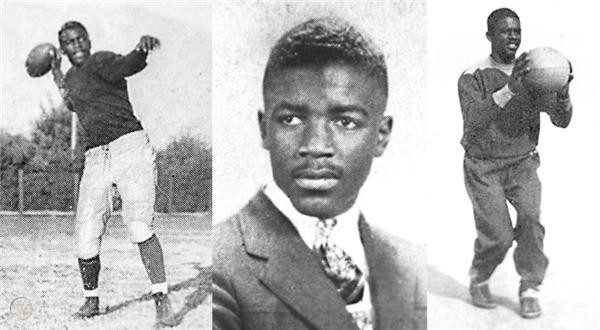
The next year, Jackie Roosevelt Robinson played for his high school’s basketball team. In the Pomona baseball tournament Robinson and Pasadena Muir faced off versus Williams and his San Diego Hoover squad in the championship game, which included three hits and a stolen home base from Robinson, and a towering 450-foot home run from Ted Williams. After graduation he opted to attend Pasadena City College. That summer Robinson played many other sports, including golf. The first time he set foot on Pasadena’s Brookside Park Course, he shot 90.
A four-sport superstar for Pasadena City College, Jackie Roosevelt Robinson was known for leading his teams to conference and or state titles in each sport. In football, he holds a Pasadena City College record that can never be broken for longest run from scrimmage, 99 yards, and he held records that were not broken until 2001 for most touchdowns and most points in a season. In track and field, he broke his own older brother, Mack Robinson’s, national community college record.
Some home games were played at the Rose Bowl. In a game in 1938 against Cal Tech, Robinson returned a kickoff for 104 yards, still a stadium record. Robinson played games in the Rose Bowl but never participated in the official New Year’s Day Rose Bowl game.
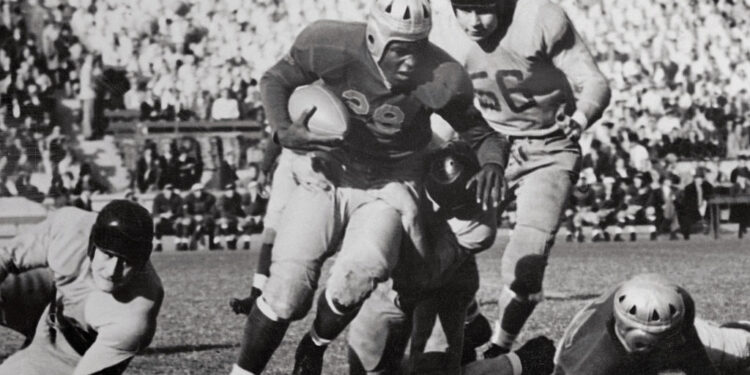
It was in 1938 while competing for Pasadena City College, that Jackie Roosevelt Robinson established the world lead in the long jump at 25 feet, 6 1/2 inches in Claremont. Robinson then went on to finish third at the National AAU Championships with a jump of 24′ 2 1/4″ . In 1940 He had three of the top seven jumps in the world and at one point had the longest seven out of 10.
At Pasadena Junior College, Robinson inhabited the shortstop spot on the Bulldogs, “handling the situation ably,” according to the 1937 yearbook. Seemingly he was a good player, the yearbook mentions he was a good fielder and on numerous occasions Robinson’s bat was a decisive force. He also joined Mack on the school’s track team, where the two were friendly rivals.
Jackie Roosevelt Robinson: The UCLA Years
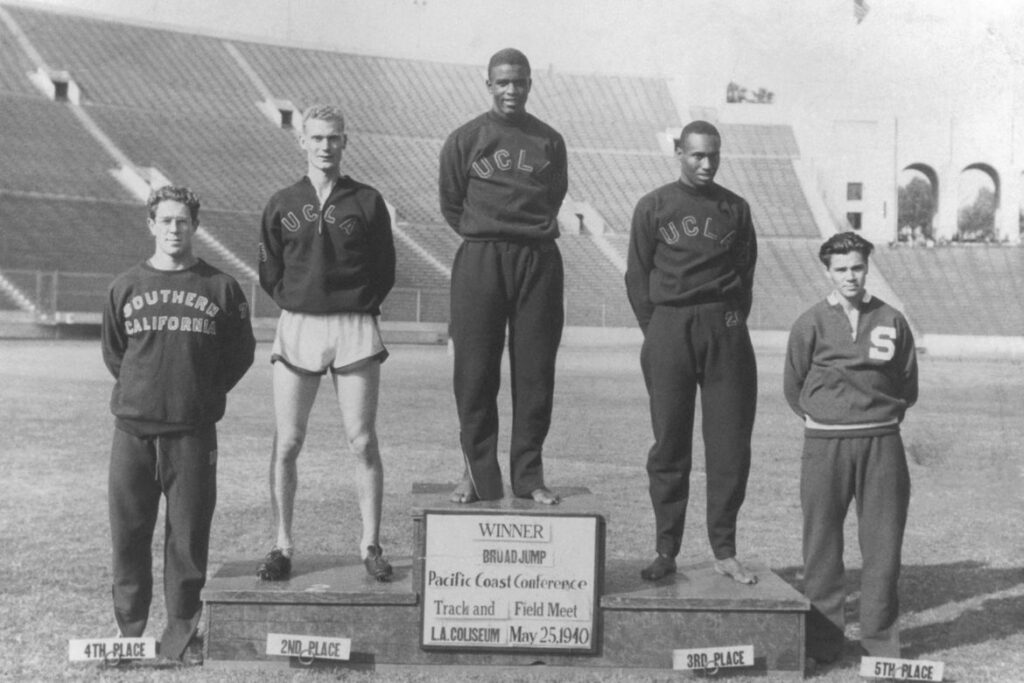
Robinson became an All-American football player who set the UCLA record for yards per carry in a season at 12.2 yards per attempt on 42 carries in 1939. He led the country in punt return average in 1939 and 1940. Robinson starred in a UCLA backfield that featured a future Hollywood actor (and inspiration for a “Toy Story” character) Woody Strode, and he made a critical goal-line tackle in front of more than 103,000 fans in a scoreless tie facing, eventual national champion, Southern California in the Los Angeles rivals’ regular-season finale.
The student newspaper for a rival, Stanford called him “Lightning Jackie Robinson”, he was a big play merchant: According to the New York Times, he returned a punt 64 yards in a game October 7th 1939 helping the Bruins best the Washington Huskies. Three weeks later, he caught a touchdown pass and tore 66 yards through the Ducks, scoring to outpace Oregon. In addition to starring on offense and special teams, Robinson also excelled at safety on defense.
On that 1939 team, Jackie Roosevelt Robinson was one of four Black players for the Bruins, which made it among the most integrated squads in major college football team at the time. At UCLA, he was an All-Western Conference quarterback and defensive back. He led the nation in punt returns in 1939 and 1940. The 1939 Bruins, who went 6-0-4, also included, Woody Strode, Kenny Washington and Ray Bartlett making it among the nation’s most racially integrated squads.
In 1940, he was the Bruins leader in passing (444 yards), rushing (383 yards) and scoring (36 points). His 1940 UCLA Bruins were coached by Babe Horrell, finishing seventh in the final AP Poll. Robinson was named All-Conference.
UCLA Coach Edwin “Babe” Horrell, was like Jackie Roosevelt Robinson, a transplant who originated elsewhere but flourished in the California sun. Born in Jackson, Missouri, September 29, 1902, he was, also like Robinson, in that he was an athletic chameleon, Horrell lettered in five sports, football, basketball, track, tennis and swimming. Despite being a man of his era, he had competed against USC’s first Black player and first All-American football player, Brice Taylor, in 1924. So he seemed to embrace the chance to coach players who were great, including Black ones.
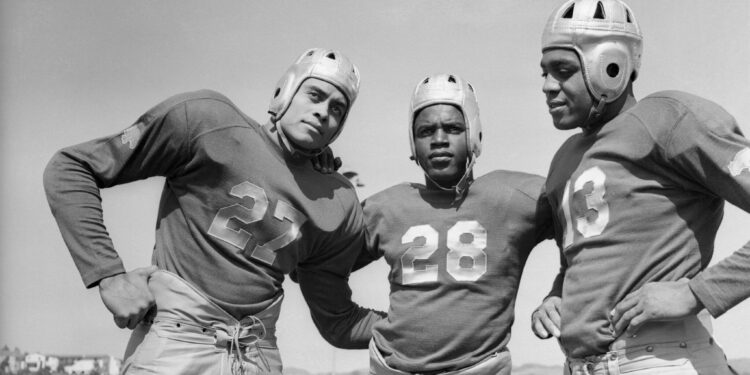
In 1941, Jackie Roosevelt Robinson lettered in track, baseball, basketball and football at UCLA (still the only Bruin to letter in four varsity sports), he also played in the annual NFL-College All-Star game. Dick Plasman, [the last helmet-less player in the NFL] of the Chicago Bears called Jackie the fastest man he’d ever seen in a uniform, after he ran over, around and through the NFL champions. “He’s the fastest thing I’ve ever seen,” said Wilbur Johns, Jackie’s basketball coach at UCLA.
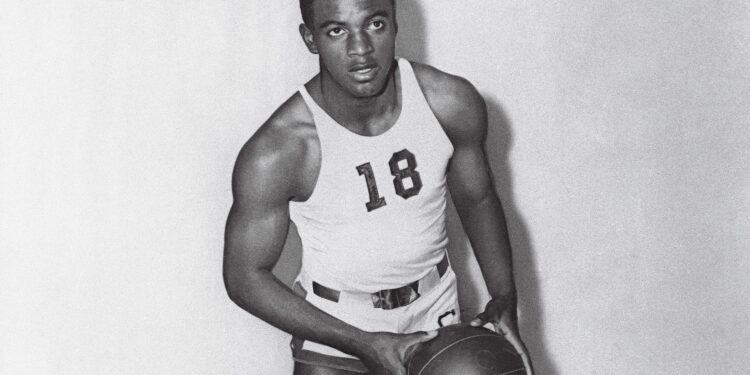
It has been widely reported that Johns insisted that if Robinson hadn’t played football, baseball, and run track, he could have been the greatest basketball player ever. Jackie averaged 12.4 points per game and 11.1 rebounds, respectively, in his two seasons at UCLA, earning All-PCC Southern Division in 1940. Robinson scored about 40 percent of UCLA’s points. If this is considered based on proportion, this is close to Wilt Chamberlain did for the Philadelphia Warriors in his record-setting 1961-62 season.
Stanford guard Ken Davidson called him the best player in the conference. Robinson bested USC All-American Ralph Vaughn, the current west coast basketball golden boy, who had been on the cover of Life magazine, for the first of his, back-to-back Conference Southern Division, scoring titles.
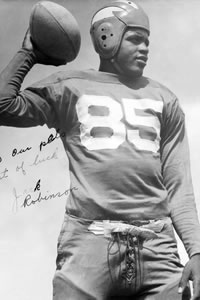
Jackie Roosevelt Robinson: Semi-Pro
By now Jackie Roosevelt Robinson was 5’113/4” 207, more than 25 pounds heavier than when he arrived at UCLA and had figured his chances of playing for a major league team after graduation were slim, given the racism of the era, so in 1941 he left college, just prior to graduation, taking a job as an assistant athletic director with the National Youth Administration in Atascadero, California. The position, however, was short-lived as, government funding, ended the next year.
After the NYA ceased operations, Robinson traveled to Honolulu to play in the Pacific Coast Football League. The PCFL was similar to baseball’s Pacific Coast League, which was a minor league because of its geographical distance from the major leagues. The major difference between the baseball and football Pacific Coast leagues was that Blacks could play in the football league, but not the baseball league.
Jackie Roosevelt Robinson signed late in the 1941 season and was hailed as a hero in the local newspapers. He arrived September 17, 1941, aboard the Matsonia. Another Black player, Ray Bartlett of UCLA, came with him, also to play for the Bears, of the Pacific Coast league. They were known as an “integrated” team. I do not known if Bartlett roomed with Jackie, but it seems likely.
Robinson practiced at Palama’s football field on the first evening he was in town. Jackie Roosevelt Robinson played his first professional game, for $100 per game, at Schofield Barracks the following Sunday. “Robinson gave 8,000 fans a lot to talk about. All they say about the Negro Flash is true,” was in a report in the Star-Bulletin, written in the vernacular of the day.
In that first game, which the Bears won 27-6, Robinson intercepted a pass and ran it back 37 yards. Later, playing quarterback, he completed three straight passes for a total of more than 50 yards and a touchdown.
“He showed off his vaunted passing ability which surpasses even his running,” the article praised. The next week Robinson’s Bulldogs faced off against Kenny Washington’s Bears. The Bulldogs took a 10-3 lead into the fourth quarter behind Robinson’s efficient play at quarterback, but the Bears rallied to win the game behind two touchdown passes by Washington.
More than 20,000 fans attended his next game at Honolulu Stadium, and Robinson scored his first rushing touchdown. But, this team of mainland and local stars lost, and would only win once more that season. By early December, Jackie Roosevelt Robinson had injured his ankle, and his brief Honolulu pro football career limped to an end. Soon, he sailed back to the mainland aboard the Lurline on December 5, 1941, just two days before the bombing of Pearl Harbor.
“I arranged for ship passage and left Honolulu on December 5, 1941,” recalled Robinson, “two days before the Japanese bombed Pearl Harbor. The day of the bombing we were on the ship playing poker, and we saw the members of the crew painting all the ship windows black. The captain summoned everyone on deck. He told us that Pearl Harbor had been bombed and that our country had declared war on Japan.
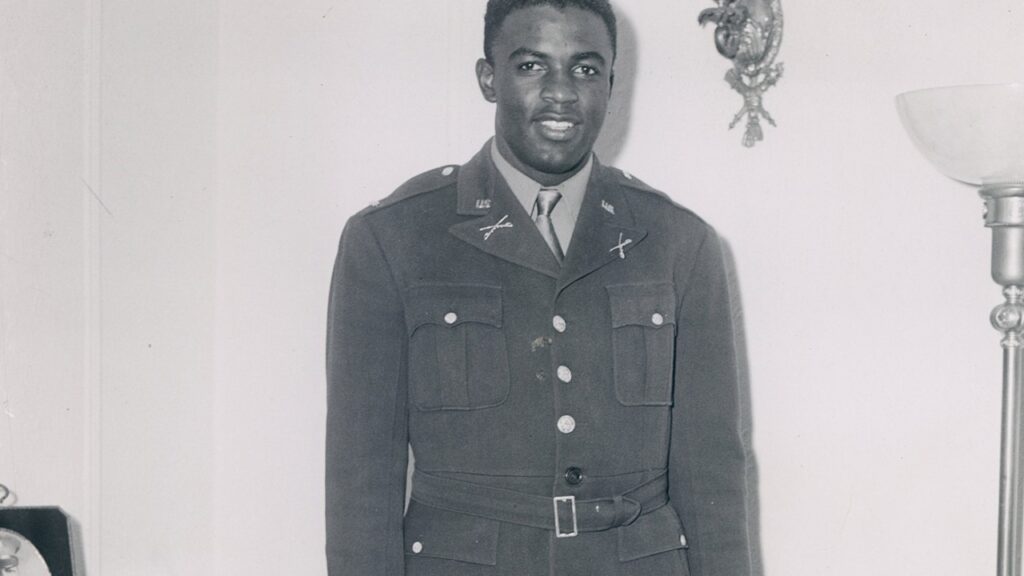
The Army Years
Robinson was able to secure a commission as an officer in the United States Army on January 28, 1943, after completing the first integrated 13-week OCS course. Only an average of one in 10 of the 78 commissioned officers were Black. Robinson wasn’t the only athlete of note in his class. Pete Bostwick, six-time winner of the US Open Polo Championship, was one of the country’s leading steeple-chasers.
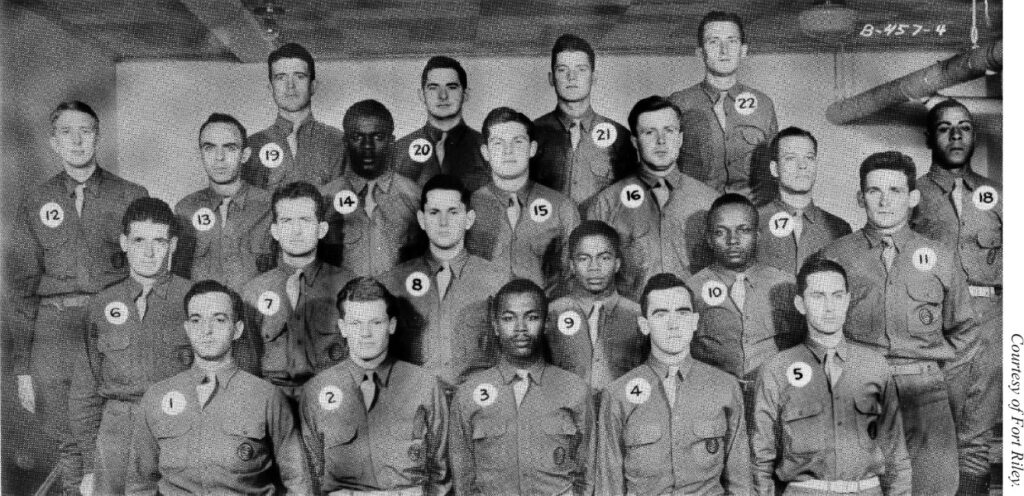
He never saw combat for a variety of reasons, including the racism he encountered. Jackie Roosevelt Robinson was an Army officer until November of 1944. He was court-martialed in 1944 when he refused to move to the back of a “non-segregated” military bus. As his statement at the time described it:
“The bus driver asked me for my identification card. I refused to give it to him. He then went to the Dispatcher and told him something. What he told him I don’t know. He then comes back and tells the people that this [n—] is making trouble. I told the driver to stop f–ing with me, so he gets the rest of the men around there and starts blowing his top and someone calls the MP’s.”
From: I Never Had It Made: The Autobiography of Jackie Robinson
Robinson, J., Duckett, A., West, C., & Aaron, H. (1995). I never had it made : an autobiography of Jackie Robinson. Ecco Press.
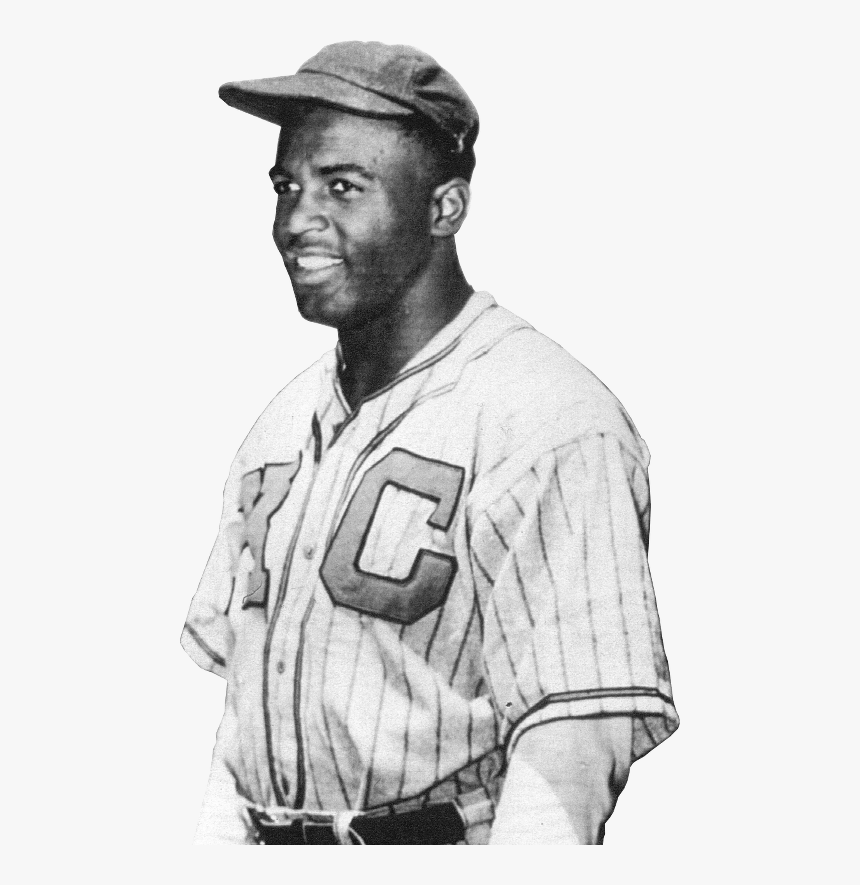
Jackie Roosevelt Robinson:The Negro Leagues
He was later acquitted and soon after his honorable discharge rejoined in the PCFL in 1944. Robinson briefly returned to the Bulldogs, and it appeared that he never missed a beat. In Robinson’s first game back he threw two touchdown passes, in limited action, and a week later he rushed for 101 yards on only eight carries in a victory over the Hollywood Wolves. Jackie Roosevelt Robinson’s football career ended a week later when he re-injured his ankle on the first play of the game against the San Diego Bombers.
Afterwards in the late summer of 1944 Robinson joined the Kansas City Monarchs of the Negro leagues. Jackie Roosevelt Robinson played shortstop in 47 games hitting .387 with 5 home runs and 13 stolen bases, enough to make the 1945 Negro League All-Star game.
Branch Rickey met with Robinson in August of 1945, told him that he needed to know if he had the “guts enough not to fight back,” and Robinson’s football and Negro league careers were now officially over. He was now on an arc to break through the wall of racism erected around America’s pastime.
Jackie Roosevelt Robinson: The Noble Experiment
On April 16, 1945, the Boston Red Sox gave a tryout to Jackie Robinson, Sam Jethroe and Marvin Williams. Jethroe was the Negro American League batting champion in 1944, having batted .353 and Williams was a standout second baseman for the Philadelphia Stars. Boston councilman and integrationist, Isadore H. Y. Muchnick, had worked with Wendell Smith of the Pittsburgh Courier to name candidates to present to Red Sox general manager Eddie Collins and Boston Braves general manager John Quinn.
After giving the players, Smith and Muchnick, the runaround about fulfilling a promise to hold a tryout, the councilman called both organizations on their stalling tactics. The tryout was only a ploy to appease Muchnick, who had the power to withhold a waiver allowing the Red Sox and Braves to play on Sundays. Even though the only people in attendance for the tryout were members of the Red Sox organization, the players were still subjected to racist invective.
August 28, 1945 Robinson was in the headquarters of the Brooklyn Dodgers Baseball Club, 215 Montague Street. This is where he met team president and general manager Branch Rickey to sign the contract that shifted the future of a game and a nation.
Robinson, fresh from a lone season in the Negro Leagues, was assigned to the Montreal Royals, the Triple-A International League farm team of the Brooklyn Dodgers. Canada was not Robinson’s home and French was not a language he spoke, but that season in Montreal, with his wife, Rachel, was a vital experience for both of them.
Robinson was a star in Montreal, also. Opening the 1946 season in Jersey City, Robinson went 4-for-5 with a three-run homer, four runs, four RBI and two stolen bases. By the time the Royals returned to Delorimier Stadium after the opening road trip, it was filled. In 1946, Robinson hit .349 with a .930 OPS for the Royals, including 40 stolen bases, and Montreal won the International League championship, then known as the “Little” World Series.
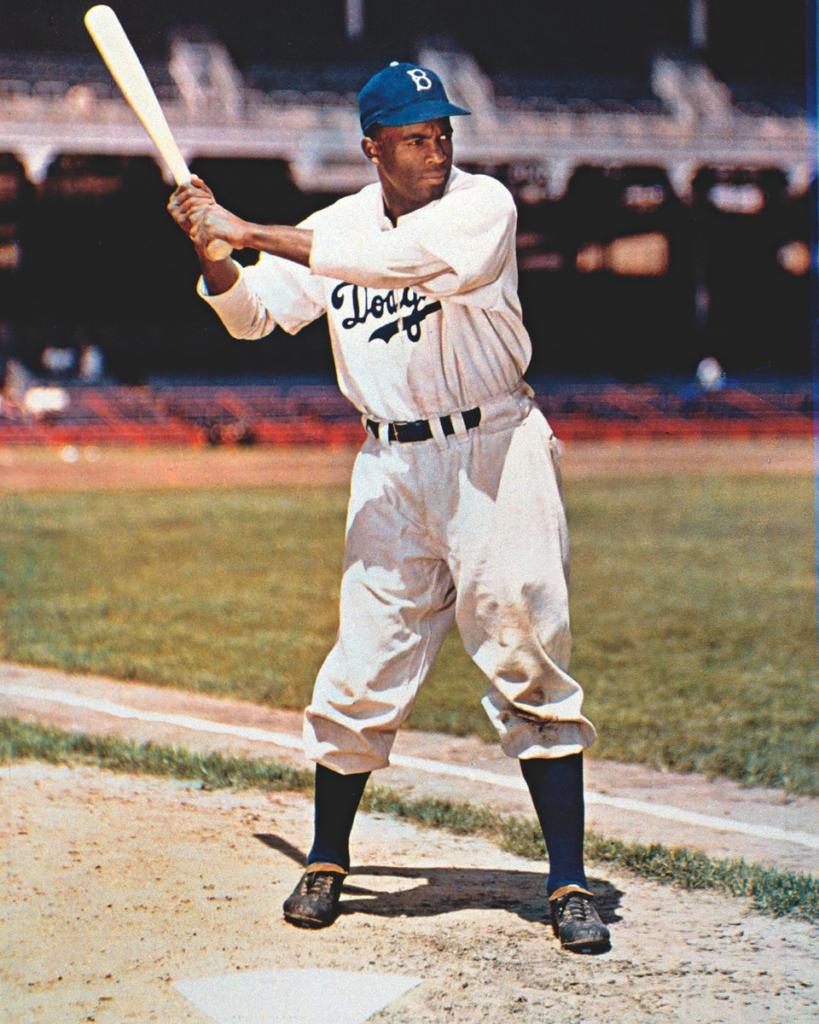
After six straight years as an All-Star, Robinson led the Dodgers to a World Series Championship, proving so many bigots and racists wrong with his leadership and exceptional play. In his 10-year, big-league career, in addition to being Rookie of the Year, National League batting champion and a six-time all-star. He was elected to baseball’s Hall of Fame in 1962.
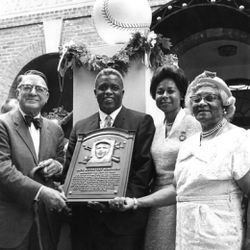
He accomplished it all while undergoing all the abuse he faced as the first Black man in major-league baseball.To quote Robinson: “I’m not concerned with your liking or disliking me. All I ask is that you respect me as a human being.”
In 1950, Branch Rickey’s contract as Dodger’s president expired, so now Robinson was now without support in the front office. His final at-bat was a strikeout in the 1956 World Series, when he went 0-for-3 in Game 7, and the New York Yankees romped in a 9-0 win. Dodgers owner Walter O’Malley, who had called Robinson “Rickey’s prima donna,” was quick to trade the 37-year-old to the New York Giants for a pitcher and $30,000. The deal was voided, however as Robinson refused to report, and instead elected to retire.
After his retirement prior to 1957 season, Jackie Roosevelt Robinson was an active participant in the struggle for civil rights, working with Dr. Martin Luther King Jr. and with the National Association for the Advancement of Colored People (NAACP). He also wrote for The New York Post and The Amsterdam News.
Rampersad, author of “Jackie Robinson: A Biography,” wrote that Robinson learned he was diabetic “about the time of his retirement,” during a routine physical. “‘He left in high spirits,’ said his friend, Jack Gordon. ‘But when he came back … he was very quiet. He said that the doctor had told him that for someone who had played sports for so long and didn’t smoke or drink, he had never seen a body so badly deteriorated.
Now that we know more about the effects of stress on the body, these results are a bit less shocking. Jackie Robinson died of a heart attack on October 24, 1972 at his home in Stamford, Connecticut. He was just 53. On March 26, 1984, Robinson was posthumously awarded the nation’s highest civilian honor, the Medal of Freedom, by President Ronald Reagan.
In 1996 the U.S. Congress and President Clinton authorized a coin to commemorate the fiftieth anniversary of Robinson’s 1947 entry into major league baseball. In 1997 the U.S. Post Office issued a stamp in his honor, and on the 50th anniversary of the date that Robinson broke major league baseball’s color barrier, Major League Baseball retired Robinson’s number 42.
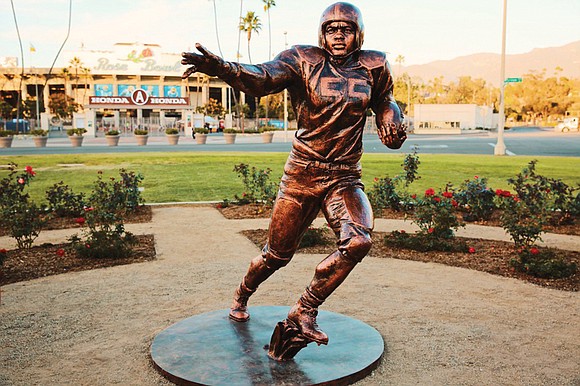


 NFL
NFL
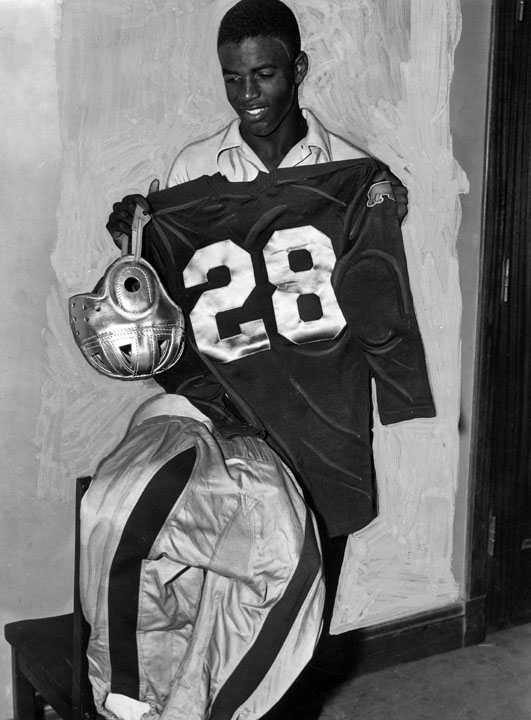
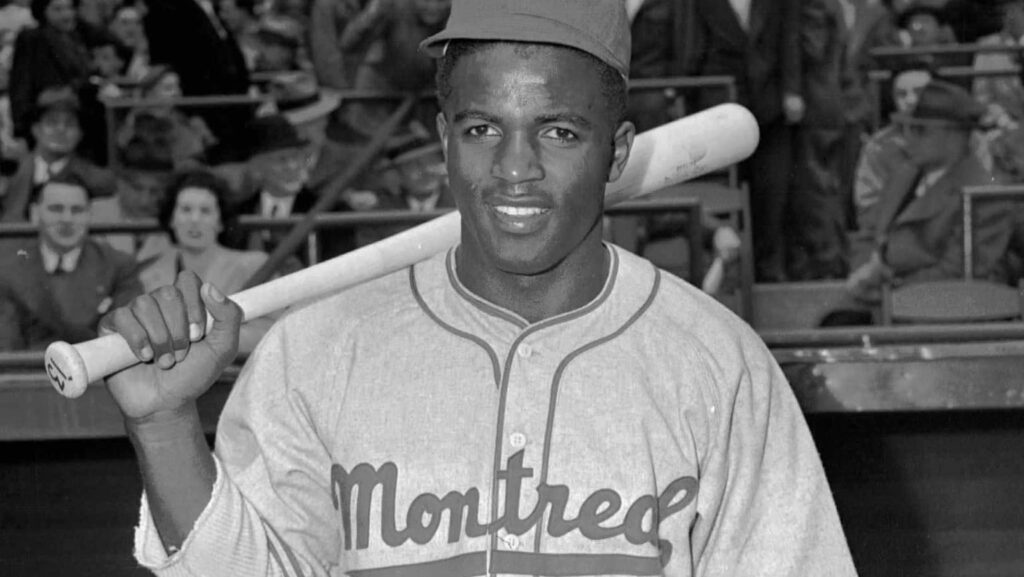
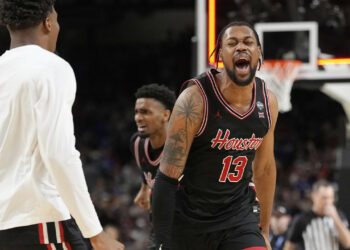
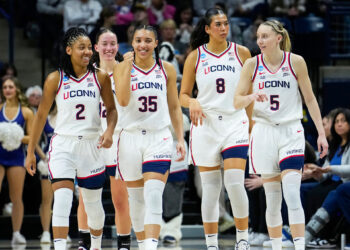
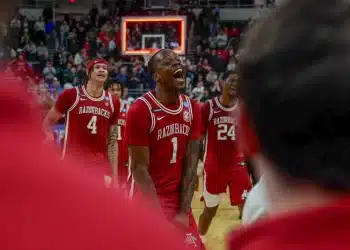
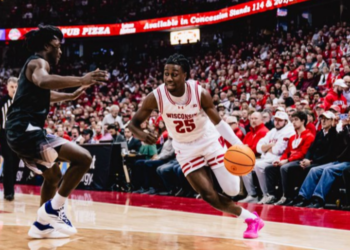


Is this how the new site is going to be? Long articles that can’t be read on the go? Super titles? I liked the old vibe you guys had I could read 2-3 articles quickly. This ain’t it in my opinion. Good luck